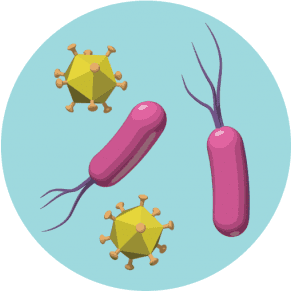What is cutaquig?
Cutaquig is a treatment for adults, children and adolescents (2 years of age and older) with primary immunodeficiency (PI) disease1
Cutaquig is used to treat adults and pediatric patients 2 years of age and older with Primary Immunodeficiency (PI) disease. There are many forms of PI. The most common types lead to an inability to make a very important kind of protein called antibodies, which protect your body against infections.1
As a ready-to-use liquid solution containing immunoglobulin G—also known as IgG—cutaquig is made from human plasma donated by healthy people.1,2 It contains the antibodies you may be missing.1 Regular use of cutaquig will help your body to fight bacteria and viruses that cause infections.1,2
 Without antibodies, you’re at greater risk for infections caused by bacteria and viruses1
Without antibodies, you’re at greater risk for infections caused by bacteria and viruses1
 Cutaquig contains the antibodies you’re missing1
Cutaquig contains the antibodies you’re missing1
 With regular administration, cutaquig helps your body fight bacteria and viruses that cause infections1
With regular administration, cutaquig helps your body fight bacteria and viruses that cause infections1
How to use cutaquig
Cutaquig is a subcutaneous immunoglobulin therapy (or SCIg).1 With SCIg, you or a parent or caregiver infuse cutaquig under the skin instead of into a vein (infusing medication for PI into a vein is known as intravenous immunoglobulin therapy, or IVIg).1
Once you’ve been trained by your healthcare provider, you’ll have the option to self-administer cutaquig.1 Like most patients, parents and caregivers who choose to self-administer, you may gain a greater sense of freedom. Plus, cutaquig offers convenience—you’ll be able to self-administer almost anywhere, including home, work, school.3-5
With cutaquig therapy, there is a low rate of side effects—mostly local infusion site reactions, including but not limited to redness, swelling, and itching.1,6 In clinical studies, 98% of local reactions were mild or moderate.6 You may experience some of these, especially if you are newly starting SCIg therapy.5 Discuss any side effects you experience with your healthcare provider, who may be able to help you address them.1
Cutaquig offers proven safety and efficacy for adults and children 2 years and older with PI1
Zero Serious Bacterial Infections1,6,7
No hospitalizations due to infection in adult AND PEDIATRIC PATIENTS 2 YEARS AND OLDER6,7
1 hospitalization in an adolescent patient due to respiratory synctial virus infection was reported in the total study population (n=61)
In a clinical study, patients taking cutaquig experienced a low rate of absences from work or school due to infection.3,4
The most common side effects are mild or moderate infusion site reactions, which usually go away within 24 hours.1
The IgCares program and its many benefits
Cutaquig is backed by the IgCares program, designed to inspire you with initiatives, including:
Care for your selfInfusion support, as well as |
Care for your spiritPersonal connections |
|||
 |
||||
Care for your causesOur charitable giving initiative |
Care for your worldOur advanced recycling program |
|||
 |
|
Care for yourselfExclusive access |
|
Care for your spiritPersonal connections |
|
Care for your causesA special initiative |
|
Care for your worldA safety and sustainability |
|
The IgCares program is complimentary.
References:
- Cutaquig Full Prescribing Information. Paramus, NJ: Octapharma; rev October 2021.
- Clinical Study Report SCGAM-01. Clinical Phase 3 study to evaluate the pharmacokinetics, efficacy, tolerability and safety of subcutaneous human immunoglobulin (octanorm 16.5%) in patients with primary immunodeficiency diseases. NCT01888484. June 2018. https://clinicaltrials.gov/ct2/show/NCT01888484. Accessed April 26, 2019.
- McCormack PL. Immune globulin subcutaneous (human) 20% in primary immunodeficiency disorders. Drugs. 2012;72(8):1087-1097.
- Kobrynski L. Subcutaneous immunoglobulin therapy: a new option for patients with primary immunodeficiency diseases. Biologics. 2012;6:277-287.
- Berman K. Safety, Efficacy, Tolerability, Advantages and Disadvantages of Intravenous and Subcutaneous Immune Globulin Therapy. Highlights from IG Living Teleconference December 10, 2015. http://www.igliving.com/life-with-ig/teleconference/advantages-and-disadvantages-of-intravenous-and-subcutaneous-immune-globulin-therapy.html. Accessed April 25, 2019.
- Kobayashi RH, Gupta S, Melamed I, et al. Clinical efficacy, safety and tolerability of a new subcutaneous immunoglobulin 16.5% (Octanorm [Cutaquig®]) in the treatment of patients with primary immunodeficiencies. Front Immunol. 2019;10(40):1-12.
- Kobayashi RH, Mandujano JF, Rehman SM, et al. Treatment of children with primary immunodeficiencies with a subcutaneous immunoglobulin 16.5% (cutaquig® [octanorm]). Immunotherapy. 2021;13(10):813 -824.